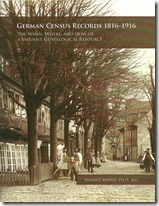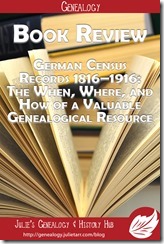 Title: German Census Records 1816–1916: The When, Where, and How of a Valuable Genealogical Resource
Title: German Census Records 1816–1916: The When, Where, and How of a Valuable Genealogical Resource
Author: Roger P. Minert
Format: Paperback
Published: 2016
My Rating: ![]()
![]()
![]()
![]()
The following review first appeared in the Federation of Genealogical Societies FORUM magazine (Winter 2016); reprinted with permission.
Census records are a keystone for those researching ancestors in the United States, as well as Canada, England, and other European countries. But for those working on their German roots, census records aren’t more than a brief mention in most German genealogy how-to books, if at all.
Roger P. Minert set out to change that by conducting an in-depth study to determine what German census records were compiled and where the records are held if they survived. After months of researching on the ground in Germany, Minert compiled his findings in German Census Records 1816–1916: The When, Where, and How of a Valuable Genealogical Resource.
The opening chapters outline the census situation from 1816 to 1916. Minert explains why censuses were taken at various points in time, how they were conducted, and the types of information collected. It is critical that readers review these opening chapters in order to understand the reasons German states conducted censuses and the challenges of locating them, especially for the period of time before unification in 1871.
The closing chapters revisit the scope of Minert’s project and provide answers to the questions he set out in his introduction. For example, his first question was to determine which German states conducted censuses. Part of the answer states: “All thirty-eight states that became members of the German Empire in 1871 conducted census[es] . . . with names of persons more than once from 1816 to 1867.” He concludes that census records, if they can be found, are another tool for genealogists researching their German roots.
The bulk of the book, chapters 5 through 42, cover the 38 states that became part of the German Empire in 1871. Each of these chapters, arranged alphabetically by the state’s German name, contains six sections: the state’s location, census enumerations, specific instructions to enumerators, content of each census, accessibility of records, and selected images. Readers will get a crash course in what censuses were taken by the state of interest, what information can be found in each, and where those records are (or might be) today. In some cases, census records can be found digitized online or on microfilm held by the Family History Library. In most cases, however, readers will come to find that many of these records need to be sought out in local and state archives in the area of interest.
Because this books covers the 38 states that made up the German Empire until 1918, today’s researchers could be dealing with archives in Germany, France, and/or Poland. Minert provides a helpful appendix that deals with contacting archives in these three countries.
While Minert doesn’t have all the answers, he has been able to compile a good amount of data regarding censuses in all 38 states of the German Empire, giving researchers another avenue to pursue. Anyone who has German roots and wants to explore the possibility of finding census records in their ancestors’ homeland should pick up a copy of this book.



Share your thoughts...